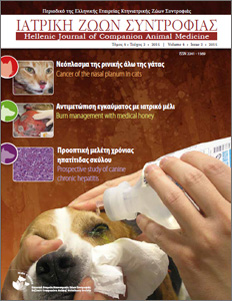Prospective study of 19 cases
> Abstract
Canine chronic hepatitis (CH) is a group of liver diseases, the causes of which are different and little known, with similar clinical presentation and laboratory findings but with differences in the histological findings, prognosis and treatment.
The current prospective study concerns 19 cases of CH that were admitted, examined, diagnosed, treated and followed up at the Companion Animal Clinic, School of Veterinary Medicine, A.U.Th. between October 2012 and October 2014. During that period, 35 animals were admitted with clinical symptoms suggestive of liver disease. However, only 19 animals with histologically confirmed CH were included in the study.
The majority of dogs were of mixed-breed with a mean age of 6.5 years. The most common symptoms included depression, anorexia and vomiting. Though observed in certain cases, disorders in the blood count were uncommon. The main laboratory finding was that of increased liver enzyme activity: alanine aminotransferase (ALT) and alkaline phosphatase (ALP). Histopathology revealed a varying degree of inflammation, mostly involving lymphocytes and plasma cells in every case, fibrosis in several cases and apoptosis and/or necrosis and regeneration in few cases. Finally, one case was characterized as copper-associated CH.











 PDF Download
PDF Download